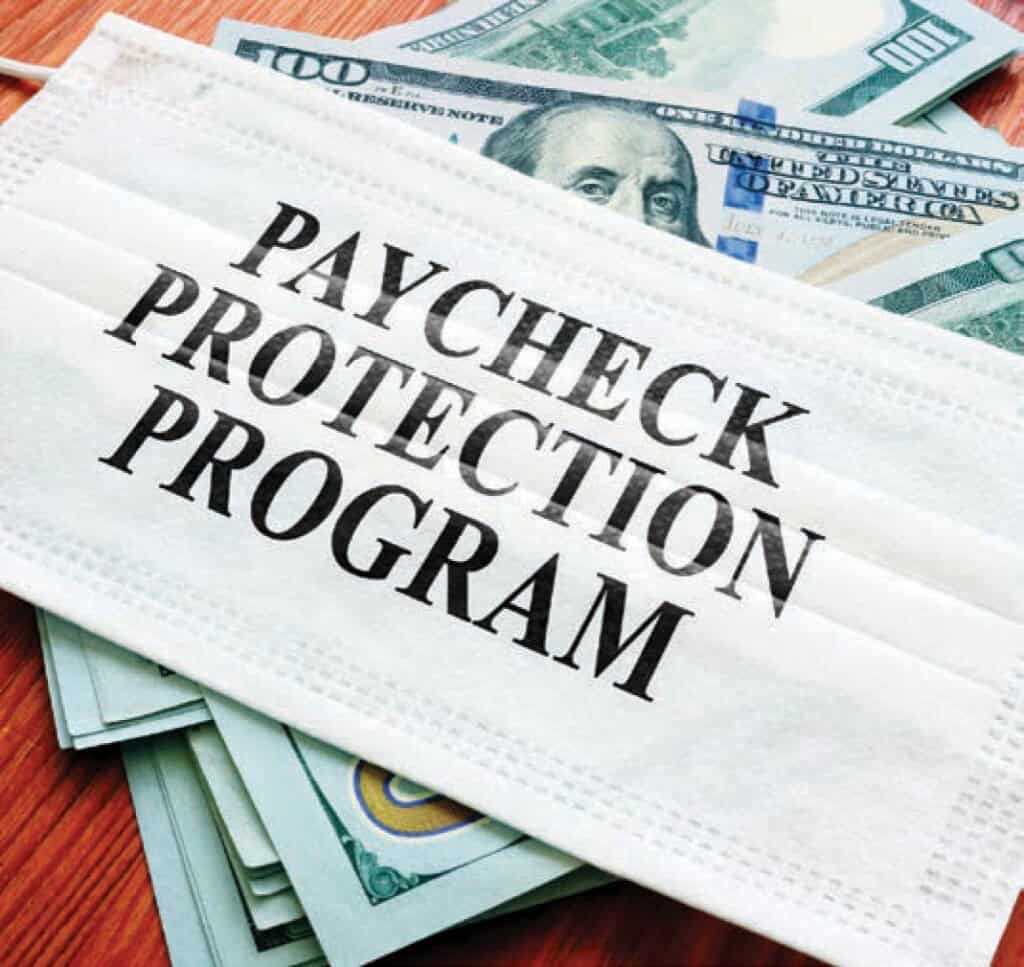PPP loans: One year later
About a year ago, the Paycheck Protection Program (PPP) was launched in response to the COVID-19 crisis. If your company took out such a loan, you’re likely curious about the tax consequences — particularly for loans that have been forgiven.
Forgiveness criteria
An eligible recipient may have a PPP loan forgiven in an amount equal to the sum of various costs incurred and payments made during the covered period. These include payroll costs, interest (but not principal) payments on any covered mortgage obligation (for mortgages in place before February 15, 2020), payments for any covered rent obligation (for leases that began before February 15, 2020), and covered utility payments (for utilities that were turned on before February 15, 2020). Also eligible are covered operations expenditures, property damage costs, supplier costs and worker protection expenses.
Your covered period would normally have been the 24-week period beginning on the date you took out the loan (ending no later than December 31, 2020, if that was before the expiration of the 24-week period). If you received a PPP loan before June 5, 2020, you could elect a shorter 8-week covered period. If you didn’t elect the 8-week period and instead used the longer 24-week period, you had to maintain payroll levels for the full 24 weeks to be eligible for loan forgiveness. If you didn’t make an election, the 24-week period applies.
An eligible recipient seeking forgiveness of indebtedness on a covered loan must verify that the amount for which forgiveness is requested was used to retain employees, make interest payments on a covered mortgage obligation, make payments on a covered lease obligation or make covered utility payments.
Cancellation and deductibility
The reduction or cancellation of indebtedness generally results in cancellation of debt income to the debtor. However, the forgiveness of PPP debt is excluded from gross income. Your tax attributes (net operating losses, credits, capital and passive activity loss carryovers, and basis) won’t generally be reduced on account of this exclusion.
The CARES Act was silent on whether expenses paid with the proceeds of PPP loans could be deducted. The IRS took the position that these expenses were nondeductible. However, the Consolidated Appropriations Act, enacted at the end of 2020, provides that expenses paid from the proceeds of PPP loans are deductible.
Any questions?
A PPP loan may complicate your company’s 2020 income tax filing. Please contact us with any questions you might have.
“Second-draw” PPP loans launched
Under the Consolidated Appropriations Act, eligible businesses may be able take out so-called “second-draw” PPP loans. These loans are primarily intended for beleaguered small businesses with 300 or fewer employees that have used up, or will soon use up, the proceeds from initial PPP loans. The maximum second-draw loan amount is $2 million, and only one such loan can be taken out.
To qualify for a second-draw loan, a company must demonstrate at least a 25% decline in gross receipts in any quarter of 2020 as compared to the corresponding quarter in 2019. Qualifying businesses can generally borrow up to 2.5 times their average monthly payroll costs for either the one-year period before the date on which the loan is made or calendar year 2019. The application deadline is March 31, 2021.
Home’s where a tax break might be
If you own a home, the interest you pay on your home mortgage may provide a tax break in the form of the mortgage interest deduction. However, you must itemize deductions on your tax return and follow a few other rules.
Acquisition debt
A personal interest deduction generally isn’t allowed, but one type of interest that is deductible is interest on mortgage “acquisition debt.” This means debt that’s: 1) secured by your principal home and/or a second home, and 2) incurred in acquiring, constructing or substantially improving the home. You can deduct interest on acquisition debt on up to two qualified residences: your primary home and one vacation home or similar property.
The deduction for acquisition debt comes with a stipulation. From 2018 through 2025, you can’t deduct the interest for acquisition debt greater than $750,000 ($375,000 for married filing separately taxpayers). So, if you buy a $2 million house with a $1.5 million mortgage, only the interest you pay on $750,000 of the total debt is deductible. The rest is nondeductible personal interest.
Higher limits on the way
Beginning in 2026, you’ll be able to deduct the interest for acquisition debt up to $1 million ($500,000 for married filing separately), barring any further legislative changes.
The higher $1 million limit also applies to acquisition debt incurred before December 15, 2017, and to debt arising from the refinancing of pre-December 15, 2017, acquisition debt, to the extent the debt resulting from the refinancing doesn’t exceed the original debt amount. Thus, taxpayers can refinance up to $1 million of pre-December 15, 2017, acquisition debt, and that refinanced debt amount won’t be subject to the $750,000 limitation.
The limit on home mortgage debt for which interest is deductible includes both your primary residence and your second home, combined. Some taxpayers believe they can deduct the interest on $750,000 for each mortgage. But if you have a $700,000 mortgage on your primary home and a $500,000 mortgage on your vacation place, the interest on $450,000 of the total debt will be nondeductible personal interest.
“Home equity loan” interest
“Home equity debt,” as specially defined for purposes of the mortgage interest deduction, means debt that is secured by the taxpayer’s home, and isn’t “acquisition indebtedness” (meaning it wasn’t incurred to acquire, construct or substantially improve the home).
From 2018 through 2025, there’s no deduction for interest on a home equity loan unless you use the loan proceeds to buy, build or substantially improve your main home or second home. Other requirements apply. Interest on the home equity loans that are used to pay personal living expenses, such as credit card debts, is not deductible.
More information
Your home is valuable in many ways. Contact us with questions or if you’d like more information about the mortgage interest deduction.
Have a foreign account? File an FBAR
Any U.S. person who has a financial interest in, or signature or other authority over, any foreign financial accounts must file a Report of Foreign Bank and Financial Accounts (FBAR) if the aggregate value of the foreign financial accounts exceeds $10,000 at any time during the calendar year. Let’s explore more of the pertinent details.
Persons and accounts
A “U.S. person” is generally a U.S. citizen, including a child. However, a U.S. person may be an individual who’s a resident alien of the United States, District of Columbia, Native American lands (as defined in the Indian Gaming Regulatory Act), or the Territories and Insular Possessions of the United States.
Also qualifying as a U.S. person is an entity — including a corporation, partnership, trust or limited liability company — organized or formed under federal law or the law of any state, the District of Columbia, U.S. Territories and Insular Possessions, or Native American tribes.
A “foreign financial account” is a financial account located outside the United States. For FBAR purposes, the United States includes the states themselves as well as the District of Columbia, U.S. Territories and Insular Possessions, and Native American lands.
An account maintained with a branch of a U.S. bank that’s physically located outside of the United States is a foreign financial account. An account maintained with a branch of a foreign bank that’s physically located inside of the United States isn’t a foreign financial account.
What defines interest
A U.S. person has a financial interest in a foreign financial account if the U.S. person is the owner of record or holder of legal title, regardless of whether the account is maintained for the benefit of the U.S. person or for the benefit of another person.
A financial interest may also exist if the owner of record or holder of legal title is one of several listed entities. These include entities controlled by the U.S. person or an agent, a nominee, an attorney or someone acting in another capacity on behalf of the U.S. person.
Penalty amounts
Civil penalties for nonwillful violations can exceed $10,000 per violation, as adjusted for inflation. For willful violations, civil penalties can range up to the greater of $100,000 as adjusted for inflation or 50% of the amount in the account at the time of the violation. Contact us for more information.
Reconsidering your personal emergency fund
When the COVID-19 pandemic first hit, many people’s emergency funds were suddenly put to the test — if the funds existed at all. Now, about a year later, and presumably with the benefit of some hindsight, you might want to reconsider your savings for a rainy day. You’ve probably heard that, to guard against an emergency, you need to save enough to cover three to six months of living costs. But this rule isn’t as straightforward as it may sound.
An emergency cushion is indeed important — and it’s certainly better to be conservative rather than cavalier when estimating your financial requirements. However, believe it or not, there may be a danger to saving too much in certain vehicles. For example, if you put away substantially more than you’ll reasonably need in a low-interest savings account, you may lose money to inflation over time. Plus, you might miss out on opportunities to invest those funds in tax-advantaged retirement accounts or other assets.
Rather than blindly following a rule of thumb, tailor your emergency savings to your financial situation. A smaller emergency fund may suffice if, for instance, your spouse has a reasonably secure job; you have relatives who can provide financial assistance in an emergency; or you have reason to believe that you’d be able to find other work quickly should you lose your job. Conversely, if you’re the sole breadwinner or you simply have a low tolerance for risk, a bigger emergency fund is likely appropriate. Our firm can help you find the right balance.
Tax Calendar
March 15 — 2020 tax returns must be filed or extended for calendar-year partnerships and S corporations. If the return isn’t extended, this is also the last day for those types of entities to make 2020 contributions to pension and profit-sharing plans.
March 31 — Electronic filing of Forms 1097, 1098, 1099, 3921, 3922, and W-2G. File Forms 1097, 1098, 1099 (except a Form 1099-NEC reporting nonemployee compensation), 3921, 3922, and W-2G with the IRS. This due date applies only if you file electronically. Otherwise, see All businesses under March 1, earlier.
The due date for giving the recipient these forms generally remains February 1.
For information about filing Forms 1097, 1098, 1099, 3921, 3922, and W-2G electronically, see Pub. 1220.
April 12 — Employees who work for tips. If you received $20 or more in tips during March, report them to your employer. You can use Form 4070.
April 15 — Individuals. File a 2020 Form 1040 or Form 1040-SR and pay any tax due. If you want an automatic 6-month extension of time to file the return, file Form 4868 and pay what you estimate you owe in tax to avoid penalties and interest. For more information, see Form 4868. Then, file Form 1040 or Form 1040-SR by October 15.
If you’re not paying your 2021 income tax through withholding (or won’t pay in enough tax during the year that way), pay the first installment of your 2021 estimated tax. Use Form 1040-ES. For more information, see Pub. 505.
Household employers. If you paid cash wages of $2,200 or more in 2020 to a household employee, you must file Schedule H (Form 1040), Household Employment Taxes. If you’re required to file a federal income tax return (Form 1040 or Form 1040-SR), file Schedule H (Form 1040) with the return and report any household employment taxes. Report any federal unemployment (FUTA) tax on Schedule H (Form 1040) if you paid total cash wages of $1,000 or more in any calendar quarter of 2019 or 2020 to household employees. Also, report any income tax you withheld for your household employees. For more information, see Pub. 926.
Corporations. File a 2020 calendar year income tax return (Form 1120) and pay any tax due. If you want an automatic 6-month extension of time to file the return, file Form 7004 and deposit what you estimate you owe in taxes.
Deposit the first installment of estimated income tax for 2021. A worksheet, Form 1120-W, is available to help you estimate your tax for the year.
* This list is not all-inclusive. See IRS Notice 2020-23, 2020-18 IRB 742 for more information.
** Any payroll taxes that are being deferred under the CARES Act or used as an advance payment for certain COVID-19-related credits don’t have to be made.
Note: It’s possible some of these due dates could be postponed (or postponed again). Contact our firm for the latest information.
About Batley CPA
Batley CPA, LLC is a full-service CPA firm providing tax, accounting, payroll and advisory services to businesses and individuals throughout Green Bay and the Fox Cities. Batley CPA regularly provides clients with best practices and strategies to maximize cash flow, profit, reduce taxes, manage costs and risk, and bring meaning to financial and operational data. The company has offices in Appleton, Neenah and Green Bay.






